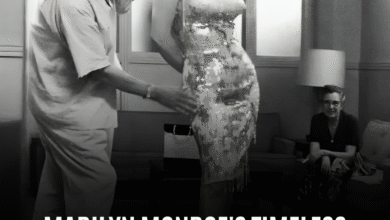Inside the House Where Marilyn Monroe Took Her Last Breath: A Deep Dive into Its Hidden History
OPINION: This article may contain commentary which reflects the author's opinion.
Marilyn Monroe’s Brentwood estate, now a renowned historical site, holds deep emotional and cultural significance. Purchased in February 1962 for approximately $77,500—half in cash and half via a mortgage—the property at 12305 5th Helena Drive in Los Angeles became the icon’s personal sanctuary. It was the first and only property she ever owned independently, symbolizing a new chapter in her life after her divorce from playwright Arthur Miller. Unfortunately, she lived there for only a few months before her untimely death at the age of 36 on August 5, 1962, leaving the estate forever tied to her memory and legacy.
The Estate’s Significance in Monroe’s Life
Monroe’s time at the estate marked a period of personal introspection and a desire for privacy. The house, originally built in 1929 in the Spanish Colonial Revival style, became her sanctuary, far removed from the public eye that followed her every move. Monroe’s efforts to personalize the space—adding authentic furniture, tapestries, and even planting an herb garden—reflected her wish for normalcy and peace. She famously described the estate as a “fortress where I can feel safe from the world,” highlighting her need for solitude amidst the pressures of fame.
The home’s historical significance grew even more poignant with Monroe’s performance of “Happy Birthday” to President John F. Kennedy and her first Vogue photoshoot during her brief stay at the residence. Her presence at the estate also underscored her desire to reclaim a sense of control and independence, despite her personal struggles and the public demands that loomed over her.
Architectural and Physical Features
The property, spanning more than half an acre with a 2,624-square-foot main house, showcases a unique blend of Spanish Colonial Revival elements, such as adobe walls, red-tile roofs, and a charming L-shaped layout. Among the estate’s key features are:
-
4 Bedrooms, 3 Bathrooms: Expanded from the original 2-bedroom layout, offering ample space for the actress to host and unwind.
-
Outdoor Living Areas: A sparkling, freeform swimming pool, a citrus grove, and a courtyard patio. The grounds also feature trees Monroe herself planted, providing a lasting connection to her time there.
-
Guesthouse and Office: The estate includes a one-story guesthouse and an office that opens onto the patio and pool area, designed for both personal and professional use.
-
Personal Decor: Monroe’s artistic touches included decorative tiles, mirrors, and textiles from Mexico, along with an inscription on the tiles reading “Cursum Perficio,” meaning “I have completed my journey”—a poetic and tragic nod to her life and death.
The Sales Journey and Market Value
Over the years, the estate has changed hands multiple times, with each transaction highlighting its cultural appeal and the significance of Monroe’s association with the property. The market value of the estate has surged as its historical importance has become more recognized:
-
1962: Purchased by Monroe for approximately $77,500–$90,000.
-
2010: Sold for $3.85 million.
-
2017: Sold for $7.25 million, exceeding the asking price by $350,000.
-
2023: Purchased for $8.4 million by current owners Brinah Milstein and Roy Bank.
These sales illustrate the enduring allure of Monroe’s legacy and the estate’s place within the broader historical and cultural landscape. Despite modifications over the years, the home retains its exterior integrity, which has been a key factor in the estate’s preservation.
Controversy and Legal Challenges
While the estate has enjoyed protected status, recent legal battles have put its future at risk. In 2024, the Los Angeles City Council designated Monroe’s Brentwood estate as a Historic-Cultural Monument, ensuring its protection from demolition and extensive alteration. However, the current owners, who also own the adjacent property, have filed a lawsuit challenging the designation. Their argument centers on the claim that there is no tangible evidence linking Monroe directly to the house. They contend that no piece of furniture, no paint chip, and no carpet remains from her time there.
Preservationists and the LA Conservancy, however, argue that the estate’s cultural and historical value is tied to Monroe’s life and death. They assert that despite the modifications over the decades, the exterior of the house remains largely intact, reflecting the state of the property as it was during Monroe’s residency.
The legal dispute has sparked a broader conversation about the intersection of property rights and historical preservation. The case continues to unfold, with preservationists hopeful that the estate will be safeguarded for future generations to appreciate as a significant part of Los Angeles and Hollywood history.
Conclusion
Marilyn Monroe’s Brentwood estate, though a site of personal tragedy, has evolved into a symbol of her legacy. From her desire for solitude to the lasting impact of her life and untimely death, the estate is intrinsically tied to the mythos of one of Hollywood’s most iconic stars. While its future remains uncertain amid legal challenges, its status as a historical monument underscores the lasting influence of Monroe on American culture. The property serves not only as a physical reminder of her life but also as a cultural touchstone, offering insight into the actress’s complex relationship with fame, privacy, and her personal journey. As of 2025, it stands as a poignant reminder of Monroe’s enduring presence in the collective memory.





